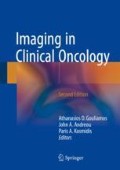Abstract
PET/CT is a hybrid method that combines anatomical imaging with metabolic information in a single examination. Fluorodeoxyglucose (FDG) is a tracer, analog to glucose, that is mainly used, currently, for PET and PET/CT imaging. The role of FDG PET/CT is complementary to conventional imaging methods. The method has a limited role in the detection of primary breast cancer and locoregional staging. It may be useful in initial staging in patients with advanced disease and in assessment of tumor response to therapy. FDG PET/CT has been shown to be effective in early restaging of patients with breast cancer and is of great importance in patients with elevated tumor markers and negative or equivocal findings on conventional imaging techniques.
Access this chapter
Tax calculation will be finalised at checkout
Purchases are for personal use only
References
Kapoor K, McCook B, Torok FS (2004) An introduction to PET-CT imaging. Radiographics 24:523–543
Scheidhauer K, Walter C, Seemann MD (2004) FDG PET and other imaging modalities in the primary diagnosis of suspicious breast lesions. Eur J Nucl Med Mol Imaging 31(1):70–79
Kumar R, Chauhan A, Zhuang H, Chandra P, Schnall M, Alavi A (2006) Clinicopathologic factors associated with false negative FDG-PET in primary breast cancer. Breast Cancer Res Treat 98(3):267–274
Rosen E, Eubank W, Mankoff D (2007) FDG PET, PET/CT and breast cancer imaging. Radiographics 27:S215–S229
Avril N, Sassen S, Roylance R (2009) Response to therapy in breast cancer. J Nucl Med 50:55S–63S
Eisenhauera EA, Therasseb P, Bogaertsc J, Schwartzd LH, Sargente D, Fordf R, Danceyg J, Arbuckh S, Gwytheri S, Mooneyg M, Rubinsteing L, Shankarg L, Doddg L, Kaplanj R, Lacombec D, Verweijk J (2009) New response evaluation criteria in solid tumours: revised RECIST guideline (version 1.1). Eur J Cancer 45:228–247
Isasi C, Moadel R, Blaufox M (2005) A meta-analysis of FDG-PET for the evaluation of breast cancer recurrence and metastases. Breast Cancer Res Treat 90:105–112
Eubank W, Mankoff D, Vessele H, Eary J, Schubert E, Dunnwald L, lindsley S, Grallow J, Austin-Seymour M, Ellis G, Livingston R (2002) Detection of locoregional and distant recurrences in breast cancer patients by using FDG PET. Radiographics 22:5
Filippi V, Malamitsi J, Vlachou F, Laspas F, Georgiou E, Prassopoulos V, Andreou J (2011) The impact of FDG-PET/CT on the management of breast cancer patients with elevated tumor markers and negative or equivocal conventional imaging modalities. Nucl Med Commun 32(2):85–90
Lee J, Rosen E, Maankoff D (2009) The role of radiotracer imaging in the diagnosis and management of patients with breast cancer: part 1-overview detection, and staging. J Nucl Med 50(4):569–581
Yap S, Seltze M, Schiepers C, Gambhir S, Rao J, Phelps M, Valk P, Czernin J (2001) Impact of whole body 18F-FDG PET on staging and managing patients with breast cancer: the referring physician’s perspective. J Nucl Med 42(9):1334–1337
Kenny L, Al-Nahhas A, Aboagye E (2011) Novel PET biomarkers for breast cancer imaging. Nucl Med Commun 32:333–335
Author information
Authors and Affiliations
Editor information
Editors and Affiliations
Rights and permissions
Copyright information
© 2018 Springer International Publishing AG, part of Springer Nature
About this chapter
Cite this chapter
Filippi, V.P. (2018). Breast Cancer: PET/CT Imaging. In: Gouliamos, A., Andreou, J., Kosmidis, P. (eds) Imaging in Clinical Oncology. Springer, Cham. https://doi.org/10.1007/978-3-319-68873-2_38
Download citation
DOI: https://doi.org/10.1007/978-3-319-68873-2_38
Published:
Publisher Name: Springer, Cham
Print ISBN: 978-3-319-68872-5
Online ISBN: 978-3-319-68873-2
eBook Packages: MedicineMedicine (R0)

